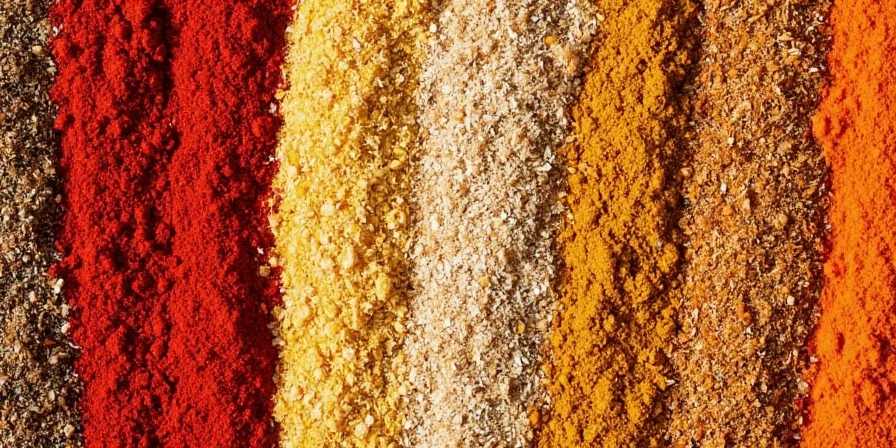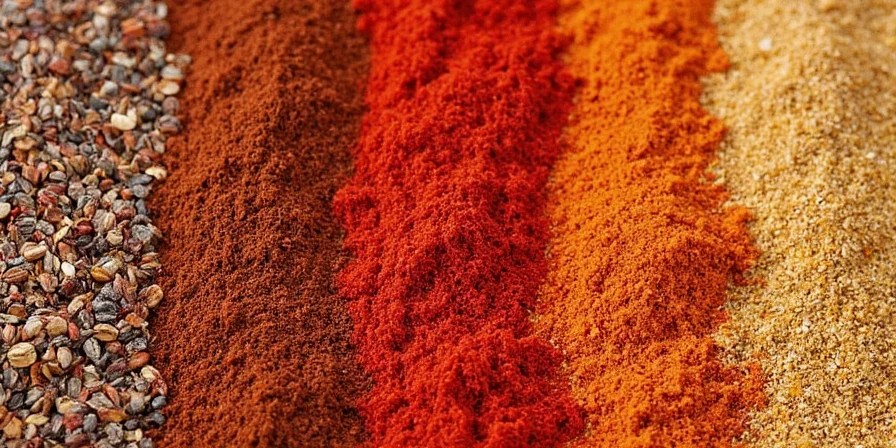Searching for spices starting with S? This comprehensive guide covers saffron, star anise, sumac, Szechuan pepper, summer savory, and essential S-spiced seeds - complete with flavor profiles, culinary applications, and science-backed usage tips. Whether you're a home cook or professional chef, discover exactly how to use these spices for perfect seasoning in every dish.
| Spice Name | Flavor Profile | Top Culinary Uses | Key Chemical Compound |
|---|---|---|---|
| Saffron | Floral, earthy, slightly bitter | Risotto, paella, baked goods | Crocin (color), picrocrocin (taste) |
| Star Anise | Licorice-like, sweet, warm | Pho, Chinese five-spice, braises | Anethole (80-90% of essential oil) |
| Sumac | Tart, citrusy, earthy | Middle Eastern salads, grilled meats | Malic and citric acids |
| Szechuan Pepper | Numbing, tingling, citrusy | Sichuan cuisine, mala dishes | Hydroxy-alpha-sanshool |
| Summer Savory | Peppery, thyme-like, minty | Bean dishes, marinades, herb blends | Thymol, carvacrol |
Why These S-Spices Belong in Your Pantry
Spices starting with S offer unique flavor dimensions that can transform ordinary dishes into extraordinary culinary experiences. Unlike generic spice guides, this resource provides precise usage guidelines based on scientific understanding of how each spice interacts with other ingredients.
Saffron: The World's Most Valuable Spice
Saffron, derived from Crocus sativus stigmas, delivers unparalleled color and flavor at just 0.1-0.2 grams per serving. Exceeding 5 grams can cause toxicity, making precise measurement crucial.

Perfect Saffron Usage Guide
- For maximum color: Soak threads in warm liquid 20 minutes before adding to dishes
- Avoid thermal degradation: Add during last 15 minutes of cooking
- Measurement precision: 15-20 threads = 0.1g for 4 servings of risotto
- Storage tip: Keep in airtight container away from light for up to 2 years
Professional chefs universally agree: never cook saffron directly in oil. Water or broth extraction preserves its delicate compounds while oil causes uneven distribution and flavor loss.
Star Anise: The Secret to Authentic Asian Flavors
This star-shaped spice contains anethole, which binds with fat molecules during slow cooking - creating layered flavor infusion impossible with ground alternatives.

Star Anise Applications by Cuisine
- Vietnamese pho: 2 whole stars per gallon, simmered 4+ hours
- Chinese red-braising: 3 stars with 1 cinnamon stick per pound of meat
- Indian garam masala: 1 star per ¼ cup blend, toasted first
- French mulled wine: 1 star per bottle, removed before serving
Don't confuse Chinese star anise (Illicium verum) with Japanese star anise (Illicium anisatum), which is toxic. The safe variety has smooth ridges on each point and a sweet licorice aroma.
Sumac: The Middle Eastern Citrus Alternative
Sumac provides tartness at a gentler pH than lemon juice, making it ideal for dishes where sharp acidity would curdle dairy or toughen proteins.

Sumac Culinary Applications
- Salad dressing: Replace ½ lemon juice with 1 tsp sumac
- Meat rubs: Combine with 2 tbsp olive oil for lamb or chicken
- Dairy-friendly dishes: Add to hummus or tzatziki without separation
- Vegetable finishing: Sprinkle on roasted vegetables before serving
For authentic za'atar spice blend, combine 2 tbsp sumac with 1 tbsp thyme and 1 tsp toasted sesame seeds. This ratio creates the perfect balance of tart, herbal, and nutty flavors.
Szechuan Pepper: Beyond Simple Heat
Szechuan pepper's hydroxy-alpha-sanshool activates touch receptors rather than heat receptors, creating the unique 'ma' (numbness) that resets taste buds between 'la' (spicy) sensations.

Szechuan Pepper Usage Guide
- Dry roasting: Heat 1 tsp in dry pan 1-2 minutes until aromatic
- Grinding: Cool completely before grinding for maximum potency
- Heat balancing: Use ½ tsp with 1 tbsp chili oil for authentic mala effect
- Storage: Keep whole berries in freezer for up to 1 year
Traditional Sichuan cooking uses a specific ratio: 40% Szechuan pepper to 60% chili for balanced mala flavor. This precise proportion creates the distinctive tingling sensation without overwhelming numbness.
Summer Savory: The Forgotten Herb
With thymol content that bridges earthy legumes and rich meats, summer savory provides balanced herbal notes without dominance - unlike more aggressive herbs like rosemary.

Summer Savory Pairing Guide
- Bean dishes: 1 tbsp chopped fresh per pound of beans
- Meat marinades: Combine with garlic and olive oil
- Herb blends: Substitute for thyme in equal amounts
- Potato dishes: Add to boiling water for enhanced flavor absorption
Unlike winter savory, summer savory has a milder flavor that works well in delicate dishes. It's the secret ingredient in traditional baked beans recipes, where it cuts through richness without overpowering other flavors.
Essential S-Spiced Seeds for Every Kitchen
These three seeds starting with S deliver maximum flavor impact with minimal effort:

| Seed | Optimal Toasting Time | Best Culinary Applications | Storage Duration |
|---|---|---|---|
| Sesame | 2-3 minutes | Asian dishes, tahini, baked goods | 6 months (toasted) |
| Mustard | 1-2 minutes | Indian curries, pickling, dressings | 1 year (whole) |
| Sunflower | 3-4 minutes | Breads, salads, energy bars | 3 months (toasted) |
Seed Toasting Science
The Maillard reaction begins at 284°F (140°C), creating complex flavor compounds. For sesame seeds: toast until golden (not brown) to avoid bitterness. Mustard seeds pop when ready - listen for the change in sound. Sunflower seeds develop their best flavor at 302°F (150°C) for exactly 3 minutes.
Spices Starting with S: Quick Reference FAQ
What spices begin with the letter S?
The most common spices starting with S include saffron, star anise, sumac, Szechuan pepper, and summer savory. Less common options are Sichuan peppercorn, Spanish paprika, and sweet marjoram.
How do I use saffron properly?
For optimal results: soak 15-20 threads in 2 tbsp warm liquid for 20 minutes, then add during the last 15 minutes of cooking. Never exceed 0.2 grams per serving (about 20 threads) for safety and flavor balance.
What's the difference between star anise and anise seed?
Star anise comes from a different plant family than anise seed but contains the same primary compound (anethole). Star anise has stronger, more complex flavor with woodsy notes, while anise seed is sweeter and more delicate.
Can sumac replace lemon juice?
Yes, sumac makes an excellent lemon substitute at a 1:3 ratio (1 tsp sumac = 1 tbsp lemon juice). Unlike lemon, sumac won't curdle dairy or toughen proteins, making it ideal for yogurt-based dishes and delicate fish preparations.
Maximizing Your S-Spice Collection
Understanding these spices starting with S transforms basic seasoning into precision flavor engineering. The key takeaway: each S-spice has unique chemical properties that determine optimal usage. Saffron's crocin disperses in liquid but degrades with heat, star anise's anethole binds with fats during slow cooking, and sumac's gentle acidity preserves delicate textures.
Professional chefs measure saffron by weight (not threads), toast star anise before use, and add sumac at the end of cooking - techniques that maximize flavor impact. By applying these science-backed principles, you'll achieve restaurant-quality results with minimal ingredients.
For best results, store all S-spices in airtight containers away from light and heat. Whole spices last up to 4 years, while ground versions maintain peak potency for 2-3 years. The true mark of quality isn't quantity of spices, but strategic application of the right spice at the right moment.

Now you're equipped with everything needed to master spices starting with S - from proper usage techniques to scientific principles behind their flavor profiles. Experiment with these guidelines to discover your perfect spice combinations.











 浙公网安备
33010002000092号
浙公网安备
33010002000092号 浙B2-20120091-4
浙B2-20120091-4